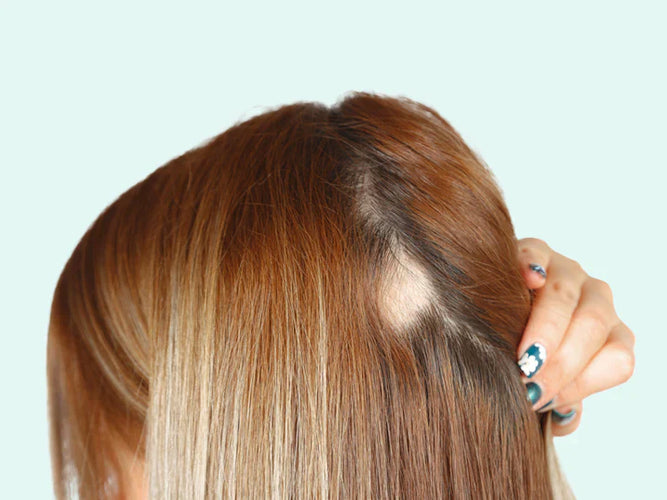A healthy scalp is essential for strong hair growth, but sometimes the immune system can attack the hair follicles themselves. This happens in lichen planopilaris, a rare inflammatory condition that mainly affects women in middle age. The disease usually develops slowly and can remain active for a long time. It causes symptoms such as redness, tenderness and gradual hair loss. Because the first signs can be subtle, the condition is often not recognised until later.
What is lichen planopilaris?
Lichen planopilaris is a rare inflammatory disease that affects the hair follicles on the scalp. The inflammation damages the follicles, which can lead to scarring. In these areas, no new hair can grow. The condition is part of the same group as lichen planus, an immune disorder that can also affect the skin, nails and mucous membranes.
The disease mainly affects women between the ages of 40 and 60, but it can also occur in men. There are three main forms:
- Classic lichen planopilaris: This type usually appears on the crown of the head. The inflammation spreads gradually and leaves behind smooth, hairless skin. The scalp may look red or purple and sometimes slightly scaly. Itching or a burning sensation are common symptoms. In some cases, the eyebrows or underarm hair may also be affected.
- Frontal fibrosing alopecia (FFA): A subtype that mainly occurs in women after menopause. In this form, the hairline slowly recedes at the front and sides of the head. The eyebrows often become thinner or fall out completely. The skin along the hairline feels smooth and tight.
-
Lassueur-Graham-Little-Piccardi syndrome: This is a very rare variant. Small bald spots with scarring appear on the scalp, sometimes combined with small scaly bumps on the arms or trunk.
What causes lichen planopilaris?
The exact cause is not yet fully understood. Most studies suggest an autoimmune mechanism, meaning the immune system mistakenly attacks the body’s own hair follicles. This triggers inflammation that can lead to permanent damage.
Factors that may influence this process include:
- Hormonal changes: especially in women after menopause.
- Stress: which can worsen inflammation in the body.
- Medication use: drugs such as antimalarials, certain blood pressure medicines and gold salts have been mentioned as possible triggers.
- Genetic predisposition: no direct hereditary link has been proven, but a genetic tendency may play a role.
It is likely that several of these factors work together in the development of the condition.
Lichen planopilaris in women
The condition occurs more often in women than in men. The frontal fibrosing alopecia (FFA) type is seen almost exclusively in women.
During or after menopause, oestrogen levels drop, which can affect the immune balance and make the scalp more prone to inflammation.
Women often notice that their hairline slowly moves backwards or that their eyebrows become thinner. Because this process develops gradually, it is sometimes only recognised at a late stage or mistaken for age-related hair loss.
How is the diagnosis made?
The diagnosis is made by a dermatologist or trichologist based on:
- Physical examination: visible bald, smooth areas with redness or flaking.
- Dermatoscopy: using magnification to examine the scalp for signs of inflammation.
- Biopsy (skin sample): microscopic examination showing inflammatory cells around the hair follicles and signs of scarring.
These tests help distinguish lichen planopilaris from other types of scarring hair loss, such as discoid lupus erythematosus or folliculitis decalvans.
What can you do if you have hair loss from lichen planopilaris?
Treatment focuses on reducing inflammation and preventing further damage. Damaged hair follicles cannot recover, but the disease process can often be stabilised.
- Consult a specialist: Only a doctor can determine the right treatment, such as corticosteroids, anti-inflammatory creams or medicines that influence the immune system.
- Avoid harsh hair products and treatments: Heat, chemical colouring and tight hairstyles can irritate the scalp.
- Reduce stress and get enough rest: This supports the skin’s natural healing process.
- Monitor changes: New red or tender spots may indicate active inflammation and should be assessed by a medical professional.
Gentle scalp care can help soothe the skin, but it does not cure the condition.
Frequently asked questions
Is lichen planopilaris contagious?
No. The condition is caused by an internal immune reaction and cannot be passed on to others.
Can lichen planopilaris go away on its own?
The inflammation may settle over time, but without treatment the disease can remain active.
Is the hair loss permanent?
Only in areas where scarring has developed will no new hair grow. With timely treatment, further hair loss can often be slowed down.
Conclusion
Lichen planopilaris is a rare scalp condition in which the immune system attacks the hair follicles. This can lead to bald patches that are sometimes permanent. The disease usually develops slowly and can remain active for a long time. It is not contagious, but it does require medical guidance to calm the inflammation and prevent further damage.
Sources
PubMed. Lichen Planopilaris: Pathogenesis, Clinical Features, and Management. National Library of Medicine. Retrieved from https://pubmed.ncbi.nlm.nih.gov
DermNet NZ. Lichen Planopilaris. Retrieved from https://dermnetnz.org
This information does not replace professional medical advice. If in doubt, always consult a doctor or specialist.













